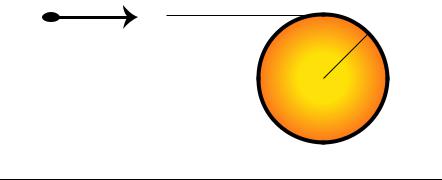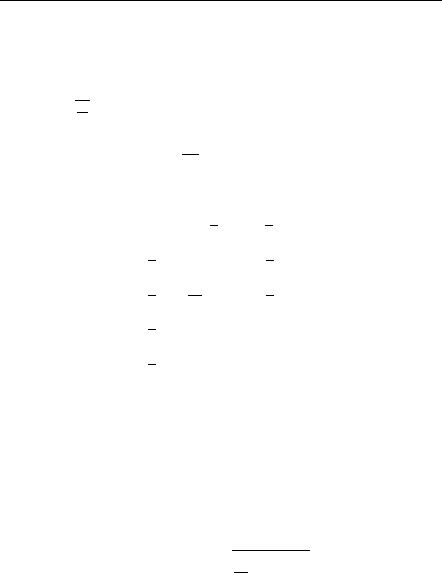
Solutions manual for mechanics and thermodynamics
.pdf
71
B) The rotational inertia about the z axis is
X
Iz = ri2mi
i
=a2M + (°a)2M + b2m + (°b)2m
=2Ma2 + 2mb2
The kinetic energy about the z axis is
Kz = 12I!2
=12(2Ma2 + 2mb2)!2
=(Ma2 + mb2)!2

72 |
CHAPTER 10. ROTATION |
7.A uniform object with rotational inertia I = ÆmR2 rolls without slipping down an incline of height H and inclination angle µ. With what speed does the object reach the bottom of the incline? What is the speed for a hollow cylinder (I = mR2) and a solid cylinder
(I = 12 MR2)? Compare to the result obtained when an object is simply dropped from a height H.
SOLUTION
The total kinetic energy is (with v = !R)
K = |
1 |
mv2 |
+ |
1 |
I!2 |
|
|
|
|
|
|
2 |
|
|
|
|
|
|
|
||||
= |
|
+ |
2 |
µR |
|
|
= (1 + Æ)2mv2 |
||||
2mv2 |
2ÆmR2 |
|
|||||||||
|
1 |
|
|
1 |
|
v |
|
2 |
1 |
|
|
Conservation of energy is |
|
|
|
|
|
||||
Ki + Ui = Kf + Uf |
|
|
|
|
|
||||
O + mgH = (1 + Æ) |
1 |
mv2 + O |
|
|
|||||
2 |
|
|
|||||||
|
|
|
|
|
|
|
|
|
|
) v = s |
2gH |
|
|
|
|
|
|||
|
|
|
|
|
|
|
|||
1 + Æ |
|
|
|
|
|
||||
For a hollow cylinder I = mR2, i.e. Æ = 1 and v = p |
|
. |
|||||||
gH |
|||||||||
For a solid cylinder I = 21 mR2, i.e. Æ = 21 |
and v = q |
|
|
||||||
|
34 gH |
||||||||
When Æ = 0,pwe get the result for simply dropping an object, namely v = 2gH.

73
8.A pencil of length L, with the pencil point at one end and an eraser at the other end, is initially standing vertically on a table with the pencil point on the table. The pencil is let go and falls over. Derive a formula for the speed with which the eraser strikes the table, assuming that the pencil point does not move. [WS 324]
SOLUTION
The center of mass of the pencil (of mass m) is located half-way up at a height of L=2. Using conservation of energy
12I!2 = mg L=2
where ! is the Ønal angular speed of the pencil. We need to calculate I for a uniform rod (pencil) about an axis at one end. This is
ZZ
I = r2dm = r2 dV
where dV = Adr with A being the cross-sectional area of the rod (pencil). Thus
I = |
|
|
Z |
|
|
|
|
|
Z L |
||||
|
|
r2Adr = A r2dr |
|||||||||||
= A 3r3 |
0 |
0 |
|||||||||||
= A L3=3 |
|||||||||||||
|
|
|
|
1 |
|
|
L |
|
|
|
|||
|
|
|
|
|
|
|
|
|
|
||||
The density is = m = |
m |
|
giving |
|
|
|
|
|
|||||
AL |
|
|
|
|
|
||||||||
V |
|
|
|
|
|
|
|
|
|
|
|
||
I = |
|
m |
L3 |
1 |
|
||||||||
|
|
|
A |
|
|
|
= |
|
mL2 |
||||
|
|
|
|
3 |
|
|
|||||||
|
|
|
|
AL |
|
|
3 |
|
|||||
We put this into the conservation of energy equation
1 1 |
|
|
|
|
|
|
|
= mg |
L |
|||||||
|
|
|
|
mL2!2 |
|
|
||||||||||
|
2 |
3 |
2 |
|||||||||||||
) |
|
1 |
|
L!2 = g |
|
|
||||||||||
|
|
|
|
|
|
|||||||||||
3 |
|
|
||||||||||||||
Now for the eraser v = L!, so that |
|
|
|
|
|
|||||||||||
1 |
L |
v2 |
= g |
|
|
|||||||||||
|
|
|
|
|
|
|
|
|
|
|
||||||
3 |
L2 |
|
|
|||||||||||||
|
|
|
|
|
|
|
||||||||||
) |
|
|
|
v2 |
= g |
|
|
|||||||||
|
|
|
3L |
|
|
|||||||||||
|
|
|
) v = p |
|
|
|
|
|||||||||
|
|
|
3gL |
|
|
|||||||||||
74 |
CHAPTER 10. ROTATION |
Chapter 11
ROLLING, TORQUE & ANGULAR MOMENTUM
75

76CHAPTER 11. ROLLING, TORQUE & ANGULAR MOMENTUM
1.A bullet of mass m travelling with a speed v is shot into the rim of a solid circular cylinder of radius R and mass M as shown in the Øgure. The cylinder has a Øxed horizontal axis of rotation, and is originally at rest. Derive a formula for the angular speed of the cylinder after
the bullet has become imbedded in it. (Hint: The rotational inertia of a solid cylinder about the center axis is I = 12 MR2). [WS354-355]
v
.
m
 R
R
M
SOLUTION
Conservation of angular momentum is
Li = Lf
The initial angular momentum is just that of the bullet, with magnitude Li = mvR. Thus
mvR = I!
where the Ønal rotational inertial I is due to the spinning cylinder and the bullet, namely
I = |
1 |
MR2 + mR2 |
|
|||||
2 |
|
|||||||
|
|
|
|
|
|
|
||
Thus |
µ |
2M + m R2 |
! |
|||||
mvR = |
||||||||
|
|
|
|
1 |
|
|
|
|
giving |
|
|
|
|
|
mv |
|
|
! = |
|
|
|
|
||||
21 M + m¥ R |
|
|||||||
|
|
|
|
|
|
|
|
|
Chapter 12
OSCILLATIONS
77

78 |
CHAPTER 12. OSCILLATIONS |
1.An object of mass m oscillates on the end of a spring with spring constant k. Derive a formula for the time it takes the spring to stretch from its equilibrium position to the point of maximum extension. Check that your answer has the correct units.
SOLUTION
The frequency of a spring, with mass m on one end is
! = s |
|
|
and ! = T |
|
m |
||
|
|
k |
2º |
The time for one complete cycle is
T = 2ºr |
|
|
|||
k |
|||||
|
|
|
|
m |
|
The time for a quarter cycle is |
|
|
|
|
|
4 = |
2 r |
|
|
|
|
|
k |
||||
|
T |
º |
|
m |
|
Check units:
The units of k are N m°1 (because F = °kx for a spring). Thus the |
||||||||||||||||||
units of |
q |
mk |
are |
|
|
|
|
|
|
|
|
|
|
|
|
|
||
|
s |
|
|
|
|
|
|
|
|
|
|
|
|
|
|
|
|
|
|
|
|
|
|
|
|
|
|
|
|
|
|
|
|
||||
|
|
|
kg |
|
= |
|
|
kg |
|
|
|
|
= p |
|
= sec |
|||
|
|
|
|
|
|
|
|
|
|
sec2 |
||||||||
|
|
N m° |
1 |
skg m sec° |
2 |
m° |
1 |
|||||||||||
|
|
|
|
|
|
|
|
|
|
|
|
|
||||||
which are the correct units for the time T4 .

79
2.An object of mass m oscillates at the end of a spring with spring constant k and amplitude A. Derive a formula for the speed of the object when it is at a distance d from the equilibrium position. Check that your answer has the correct units.
SOLUTION
Conservation of energy is
|
|
|
|
Ui + Ki = Uf + Kf |
|
|
|
|||||
with U = |
1 kx2 |
for a spring. At the point of maximum extension |
||||||||||
|
2 |
|
|
|
|
|
|
|
|
|
|
|
x = A and v = 0 giving |
|
|
|
|
|
|
|
|
||||
|
|
|
1 |
kA2 + 0 = |
|
1 |
kd2 + |
1 |
mv2 |
|||
|
|
2 |
2 |
2 |
||||||||
|
|
|
|
|
|
|
|
|||||
|
|
|
|
mv2 = k(A2 ° d2) |
||||||||
|
|
|
|
v = |
s |
|
|
|
|
|||
|
|
|
|
m(A2 |
° d2) |
|||||||
|
|
|
|
|
|
|
|
|
k |
|
|
|
Check units:
The units of k are N m°1 (because F = °kx for a spring). Thus the q
units of mk (A2 ° d2) are
ss
N m°1 m2 |
= |
kg m sec°2 m°1 m2 |
|
kg |
|
kg |
|
|
|
||
which are the correct units for speed v.
p
= m2 sec°2 = m sec°1

80 |
CHAPTER 12. OSCILLATIONS |
3.A block of mass m is connected to a spring with spring constant k, and oscillates on a horizontal, frictionless surface. The other end of the spring is Øxed to a wall. If the amplitude of oscillation is A, derive a formula for the speed of the block as a function of x, the displacement from equilibrium. (Assume the mass of the spring is negligible.)
SOLUTION
The position as a function of time is
x = A cos !t
q
with ! = mk . The speed is
v = dxdt = °A! sin !t
giving the total energy
E= K + U = 12mv2 + 12kx2
=12mA2!2 sin2 !t + 12kA2 cos2 !t
=12mA2 mk sin2 !t + 12kA2 cos2 !t
=12kA2(sin2 !t + cos2 !t)
=12kA2
(Alternative derivation:
E = 12 mv2 + 12 kx2; when v = 0, x = A ) E = 12 kA2).
The energy is constant and always has this value. Thus
1 |
= |
1 |
|
|
1 |
|||
|
mv2 |
|
|
kA2 ° |
|
kx2 |
||
2 |
2 |
2 |
||||||
|
v2 |
= |
|
k |
(A2 ° x2) |
|||
|
|
|
||||||
|
m |
|||||||
s
v = ß mk (A2 ° x2)
